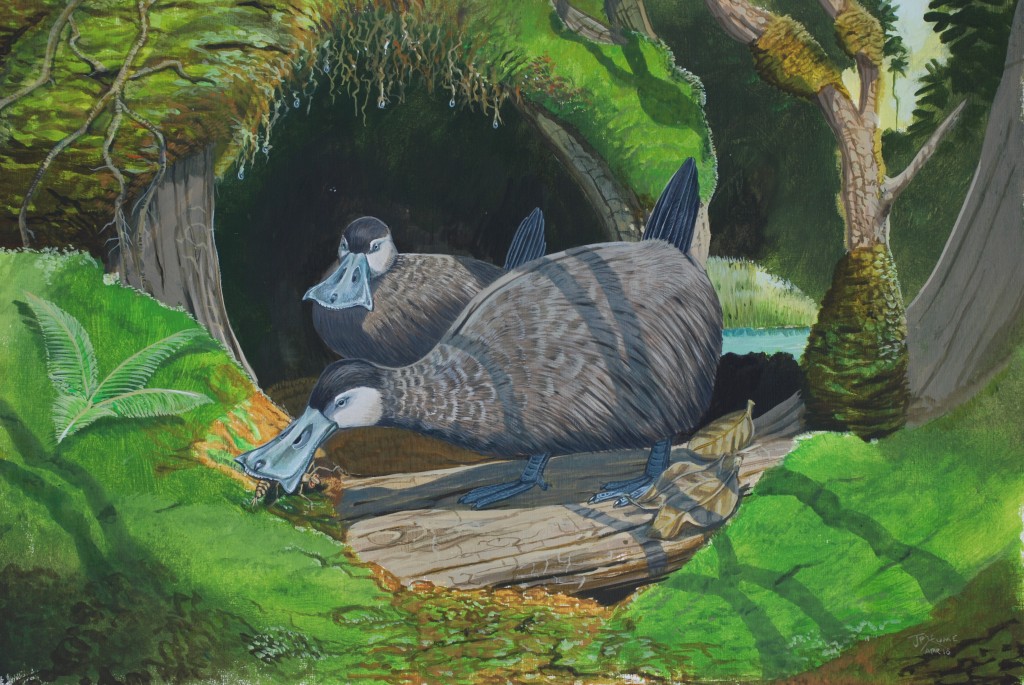Weirdest Duck of Them All
July 25, 2012

The extinct Kaua’i Mole Duck (Talpanas lippa) is known only from the fossils we have found in Makauwahi Cave. For more of Dr. Julian Hume’s paintings, see his excellent new book Extinct Birds.
I can still remember what I said that day, over 15 years ago, when I climbed out of the ever-growing East Pit excavations of Makauwahi Cave, and walked over to Storrs Olson with a peculiar skull in my muddy hand that I had just found: “Storrs, I’m embarrassed to say I can’t tell for sure whether this skull is from a mammal or a bird. It is really strange-looking.”
It was like nothing anybody had ever seen, we quickly agreed: something like an Australian platypus or a New Zealand kiwi. The eye sockets were tiny and far back on the head. The odd skull was very
flattened, with a long broad snout. Storrs reckoned it might be some kind of duck, but a very weird one indeed. We found a few more pieces of the skeleton that season, but it was over a decade later
before the experts decided what it was, and published a name, Talpanas lippa, literally “the nearly blind mole duck” (see our Resources Page for a pdf of the technical description, in Iwaniuk et al., 2009).
This pintail-sized duck was probably both blind, or nearly so, and flightless (flying blind is rather a bad idea unless you’re an echo-locating bat). We think it probably foraged in the forest, feeling about in the leaves with a big hyper-sensitive bill for invertebrates, similar to the kiwi. One of its most remarkable features was a very large opening for the nerve that carries information from the bill and face to the brain, reminiscent of the platypus, that nearly blind egg-laying primitive mammal. The creature that Americans know best with a similar set of sensory features is the mole, a blind burrowing mammal that feeds by feel and smell, as this weird duck may have done.
Rather than speculate further – and all of this is an educated guess at best – I have to draw a more general lesson from this: fossils are really important for our understanding of nature. If I hadn’t dug up
that skull (and we never found another, although I’m still looking), none of us would have ever guessed such a thing could even have existed. No computer model, no elegant theory from evolutionary biology, no modern high-tech method of any kind, would have predicted that the Kaua`i Mole Duck had ever existed. Only the richly fossiliferous mud of Makauwahi Cave could tell us this, and only if we took the trouble to make the considerable (and low-tech) effort to dig it up. I estimate that we have dug up about 2% of these rich deposits in 20 years. Who can even guess what might be in the rest?
For that matter, who can even imagine what this strange creature was really like? Our fossils were from a few thousand years ago, and we figure that such a creature, essentially blind, and completely flightless, would have been one of the first native animals to go when people, pigs, dogs, rats, and chickens arrived by canoe roughly a millennium ago. One thing for sure: if it had survived, it would be a powerful symbol of the uniqueness of the Hawaiian fauna.
Comments:
Jennifer Cantu on February 23, 2016
I am a graduate student at Ohio University. Our Museum Fundamentals class is preparing an exhibit which includes 3D printed skulls of Talpanas lippus from Dr. Witmer's lab. May I use this image as part of the display?